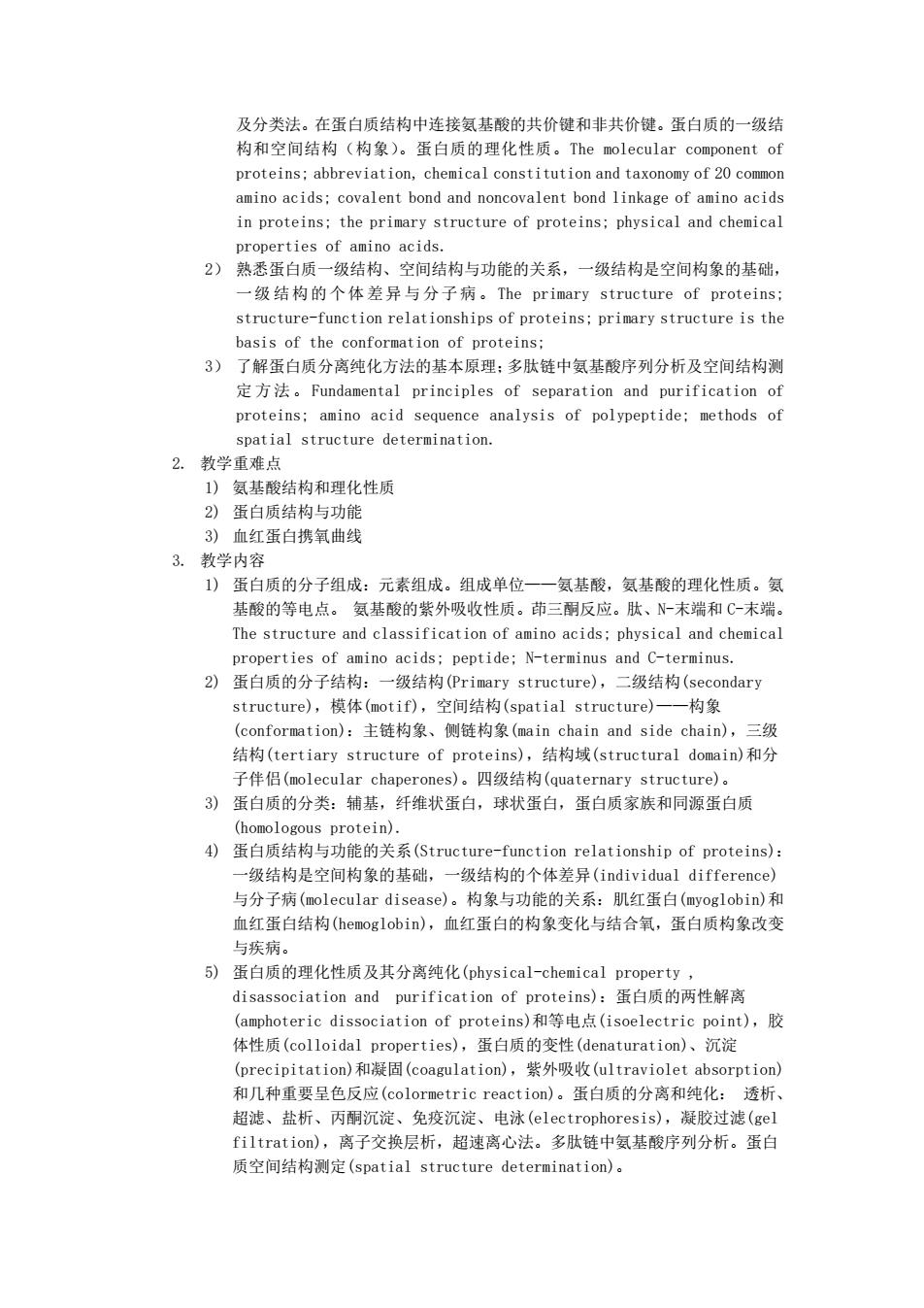正在加载图片...

及分类法。在蛋白质结构中连接氨基酸的共价键和非共价键。蛋白质的一级结 构和空间结构(构象)。蛋白质的理化性质。The molecular component of proteins;abbreviation,chemical constitution and taxonomy of 20 common amino acids;covalent bond and noncovalent bond linkage of amino acids in proteins;the primary structure of proteins;physical and chemical properties of amino acids. 2)熟悉蛋白质一级结构、空间结构与功能的关系,一级结构是空间构象的基础, 一 级结构的个体差异与分子病。The primary structure of proteins; structure-function relationships of proteins;primary structure is the basis of the conformation of proteins; 3)了解蛋白质分离纯化方法的基本原理:多肽链中氨基酸序列分析及空间结构测 定方法。Fundamental principles of separation and purification of proteins;amino acid sequence analysis of polypeptide;methods of spatial structure determination. 2.教学重难点 1)氨基酸结构和理化性质 2)蛋白质结构与功能 3)血红蛋白携氧曲线 3.教学内容 1)蛋白质的分子组成:元素组成。组成单位一一氨基酸,氨基酸的理化性质。氨 基酸的等电点。氨基酸的紫外吸收性质。茚三酮反应。肽、N-末端和C-末端。 The structure and classification of amino acids;physical and chemical properties of amino acids;peptide;N-terminus and C-terminus. 2)蛋白质的分子结构:一级结构(Primary structure),二级结构(secondary structure),模体(motif),空间结构(spatial structure)一一构象 (conformation):主链构象、侧链构象(main chain and side chain),三级 结构(tertiary structure of proteins),结构域(structural domain)和分 子伴侣(molecular chaperones)。四级结构(quaternary structure)。 3)蛋白质的分类:辅基,纤维状蛋白,球状蛋白,蛋白质家族和同源蛋白质 (homologous protein). 4)蛋白质结构与功能的关系(Structure-function relationship of proteins): 一级结构是空间构象的基础,一级结构的个体差异(individual difference) 与分子病(molecular disease)。构象与功能的关系:肌红蛋白(myoglobin)和 血红蛋白结构(hemoglobin),血红蛋白的构象变化与结合氧,蛋白质构象改变 与疾病。 5)蛋白质的理化性质及其分离纯化(physical-chemical property, disassociation and purification of proteins):蛋白质的两性解离 (amphoteric dissociation of proteins)和等电点(isoelectric point),胶 体性质(colloidal properties).,蛋白质的变性(denaturation)、沉淀 (precipitation)和凝固(coagulation),紫外吸收(ultraviolet absorption) 和几种重要呈色反应(colormetric reaction)。蛋白质的分离和纯化:透析、 超滤、盐析、丙酮沉淀、免疫沉淀、电泳(electrophoresis),凝胶过滤(gel filtration),离子交换层析,超速离心法。多肽链中氨基酸序列分析。蛋白 质空间结构测定(spatial structure determination),。及分类法。在蛋白质结构中连接氨基酸的共价键和非共价键。蛋白质的一级结 构和空间结构(构象)。蛋白质的理化性质。The molecular component of proteins; abbreviation, chemical constitution and taxonomy of 20 common amino acids; covalent bond and noncovalent bond linkage of amino acids in proteins; the primary structure of proteins; physical and chemical properties of amino acids. 2) 熟悉蛋白质一级结构、空间结构与功能的关系,一级结构是空间构象的基础, 一级结构的个体差异与分子病。The primary structure of proteins; structure-function relationships of proteins; primary structure is the basis of the conformation of proteins; 3) 了解蛋白质分离纯化方法的基本原理;多肽链中氨基酸序列分析及空间结构测 定 方 法 。Fundamental principles of separation and purification of proteins; amino acid sequence analysis of polypeptide; methods of spatial structure determination. 2. 教学重难点 1) 氨基酸结构和理化性质 2) 蛋白质结构与功能 3) 血红蛋白携氧曲线 3. 教学内容 1) 蛋白质的分子组成:元素组成。组成单位——氨基酸,氨基酸的理化性质。氨 基酸的等电点。 氨基酸的紫外吸收性质。茚三酮反应。肽、N-末端和 C-末端。 The structure and classification of amino acids; physical and chemical properties of amino acids; peptide; N-terminus and C-terminus. 2) 蛋白质的分子结构:一级结构(Primary structure),二级结构(secondary structure),模体(motif),空间结构(spatial structure)——构象 (conformation):主链构象、侧链构象(main chain and side chain),三级 结构(tertiary structure of proteins),结构域(structural domain)和分 子伴侣(molecular chaperones)。四级结构(quaternary structure)。 3) 蛋白质的分类:辅基,纤维状蛋白,球状蛋白,蛋白质家族和同源蛋白质 (homologous protein). 4) 蛋白质结构与功能的关系(Structure-function relationship of proteins): 一级结构是空间构象的基础,一级结构的个体差异(individual difference) 与分子病(molecular disease)。构象与功能的关系:肌红蛋白(myoglobin)和 血红蛋白结构(hemoglobin),血红蛋白的构象变化与结合氧,蛋白质构象改变 与疾病。 5) 蛋白质的理化性质及其分离纯化(physical-chemical property , disassociation and purification of proteins):蛋白质的两性解离 (amphoteric dissociation of proteins)和等电点(isoelectric point),胶 体性质(colloidal properties),蛋白质的变性(denaturation)、沉淀 (precipitation)和凝固(coagulation),紫外吸收(ultraviolet absorption) 和几种重要呈色反应(colormetric reaction)。蛋白质的分离和纯化: 透析、 超滤、盐析、丙酮沉淀、免疫沉淀、电泳(electrophoresis),凝胶过滤(gel filtration),离子交换层析,超速离心法。多肽链中氨基酸序列分析。蛋白 质空间结构测定(spatial structure determination)